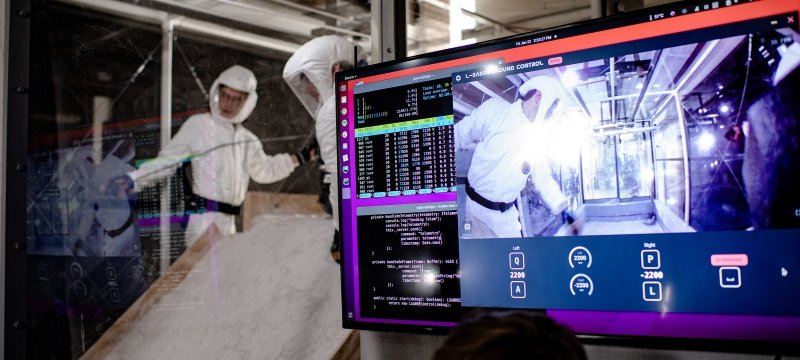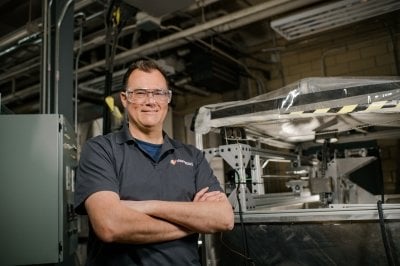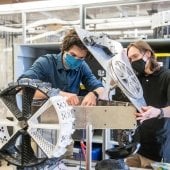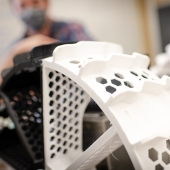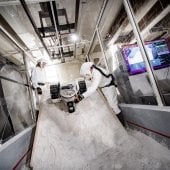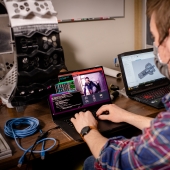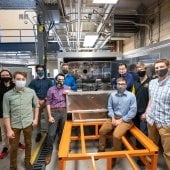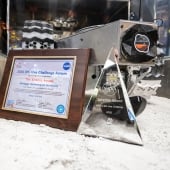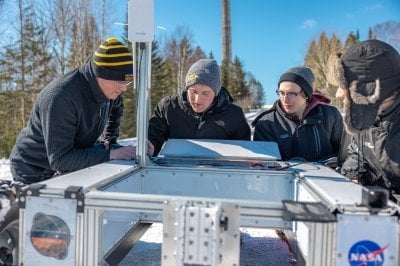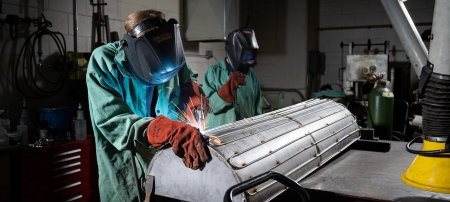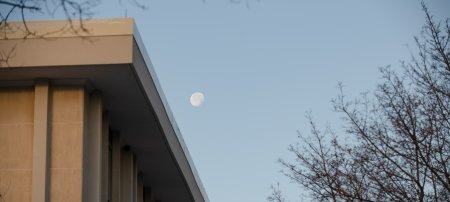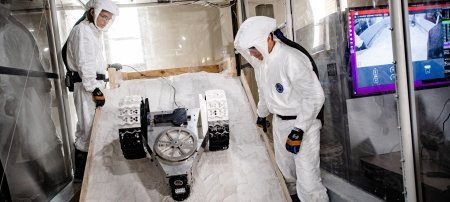Researchers in Michigan Tech's Planetary Surface Technology Development Lab work to make science fiction into reality.
Science fiction—including recent space-set movies like The Martian, Gravity, Ad Astra, and Interstellar—fascinates millions around the world. But in reality, NASA only recently launched a new program, Artemis, to get people back to the moon for the first time since 1972. The biggest human presence in space is the International Space Station, which is home to only seven people at a time.
This doesn't mean living on the moon or Mars can't happen. Paul van Susante, assistant professor of mechanical engineering-engineering mechanics, says it's inevitable—and necessary for the sake of humanity. He and his lab are working on the details of how to make actions seen in science fiction—like lunar ice harvesting in TV's popular For All Mankind—possible in real life (he admits he hasn't watched the show yet, though it's on his list).
"As an engineer, I'm an optimist. I like to solve problems, and I think technology plays a huge role in that, but technology is also a huge driver," he says. "We can invent things that allow us to do things that now seem impossible."
It Began with a Question
In 2015, van Susante attended a workshop about human landing site selection organized by NASA. It brought together experts focused in different areas of science, human exploration, and in-situ resource utilization (ISRU) to look at every angle of the challenge of landing people on Mars.
"That's where we got to talk about, 'If we're going to Mars, where would we land?'" he says. It's not as easy as picking flat ground. Together, the group considered ISRU—a practice where astronauts use the resources around them to survive instead of relying on shipments from Earth.
"We've always wanted to make people realize that if you want to go out there and do things, you can't just bring everything from Earth. You have to start using local materials," he says. It's just too cost ineffective and wasteful in terms of rocket fuel to do otherwise. According to NASA, every pound of weight requires eight pounds of rocket fuel to get it into low orbit and much more to go to other locations and return. Being able to use resources from the moon, Mars, and other locations makes life in outer space more realistic, sustainable, and affordable.
The landing site question prompted the group to identify potential sources of water and fuel. Harvesting carbon dioxide—which makes up about 96 percent of Mars's atmosphere—and hydrogen to make methane fuel was one proposal. Another was electrolyzing hydrogen and oxygen—which brought the group back to the necessity of water, which comprises both.
For potential sources of water, Mars has both buried glaciers and hydrated minerals with water contained in their crystal structure. If you unlock the crystal, you unlock the water. "You can release the water by heating it up and breaking that bond that holds the water in the mineral structure," says van Susante.
The group kept working together after the conference, hypothesizing that the best mineral water source was gypsum, which exists on Mars, is 20 percent water, and doesn't require a lot of heat to release that water. In 2017, a team from MTU and Honeybee Robotics submitted a proposal and won a $500,000 Early Stage Innovation grant from NASA to develop that technology. The MTU team included van Susante and his MTU colleagues Jeffrey Allen, professor of mechanical engineering-engineering mechanics, Ezequiel Medici, former research associate of mechanical engineering-engineering mechanics, and Timothy Eisele, associate professor of chemical engineering.
Then in 2019, van Susante became an assistant professor and, in his words, "built a lab that nobody else had."
Building the PSTDL
The Planetary Surface Technology Development Lab (PSTDL, also known as HuskyWorks) was founded in August 2019 and is dedicated to prototyping, building, testing, and increasing the technology readiness level of tech being developed for lunar and Mars missions. van Susante's startup funding was used largely to create the Dusty Thermal Vacuum Chamber, which is a vacuum-sealed room partially filled with a simulated lunar dust that can be cooled to -196 degrees Celsius and heated to 150 degrees Celsius—essentially, a simulated moon environment. In the chamber, researchers can test surface exploration systems (i.e., rovers) in about as close to moon conditions as you can get on Earth.
Having easy access to a testing facility like the PSTDL outside of NASA is crucial for academia and commercial companies given the Artemis program, which is scheduled to put people back on the moon shortly after 2024. One of its goals, in addition to landing the first woman and person of color on the moon, is to expand lunar exploration and establish a sustainable human presence.
"If you can't test this equipment anywhere, how can you know it will work?" van Susante asks.
While nothing can be a 100 percent accurate re-creation of the moon ("You can't alter gravity," van Susante jokes), the team has gotten as close as they can, including creating their own lunar dust that matches, as much as possible, the size, grit, and makeup of the real thing.
COVID-related supply chain interruptions slowed the lab's timeline to being fully operational. The same personal protective equipment (PPE) required to work in the Dusty Thermal Vacuum Chamber, which protects the researchers from the incredibly fine dust, was desperately needed by healthcare workers at the start of the pandemic. Despite the delay, the lab has been remarkably successful so far.
T-REX on the Moon
In 2020, a team of students working in the PSTDL entered NASA's Breakthrough, Innovative and Game-changing (BIG) Idea Challenge, which funded eight university teams to develop systems to research and navigate permanently shadowed regions (PSRs) on the moon. MTU received $162,637 to develop their T-REX project, which stands for Tethered permanently-shadowed Region Explorer. It's a rover that lays down lightweight, superconducting cable connected to a lander, and it won NASA's top prize—the Artemis Award.
"Since it's made of a superconducting material, you can use a really small cable, and since it's superconductive, you can transfer 10 kilowatts of energy with virtually no energy loss because you have zero resistance in the cable," says van Susante. The cable would need to be several kilometers long in order to drive down into PSRs, which he says can be done with a small vehicle like T-REX. The rover weighs 30 kilograms—about 66 pounds.
"Once you park it there, you then become a recharging and communication spot for other activity," van Susante says. "You can come up and dock a vehicle and recharge it." Such a hub could also power an ice melting plant and provide energy in PSRs, where there's no direct sunlight to create solar energy. Testing T-REX's systems in the Dusty Thermal Vacuum Chamber and its navigation on lunar-like surfaces and craters helped the students perfect their design.

Student Engineers Build a Lunar Rover—and Win BIG.
Nanosatellite launches to lunar rovers, Michigan Tech students design and build equipment that supports space missions to the moon, Mars, and beyond. Huskies won the Artemis Award in NASA's Breakthrough, Innovative, and Game-changing (BIG) Idea Challenge for their rover project. With the funding to continue development, they're working alongside faculty in the Planetary Surface Technology Development Lab, testing their designs in a simulated moonscape.
A Win Streak
In May 2021, the PSTDL built on T-REX's success. A group of MTU researchers led by van Susante created Wire Watts Wherever and Whenever You Want (W5), a lunar power infrastructure deployment mission. They entered it in NASA's Watts on the Moon Challenge, a technology design competition to imagine a next-generation energy infrastructure on the moon. Unlike the BIG Idea Challenge, this one was open to anyone with a good idea, not just teams of college students.
The PSTDL team specifically tackled the problem of delivering power from a power plant to a water extraction plant inside a crater, and showed that W5 could deliver the power at up to 93 percent efficiency from a 10-kilowatt source using superconducting tethers. They won the $100,000 grand prize in this category.
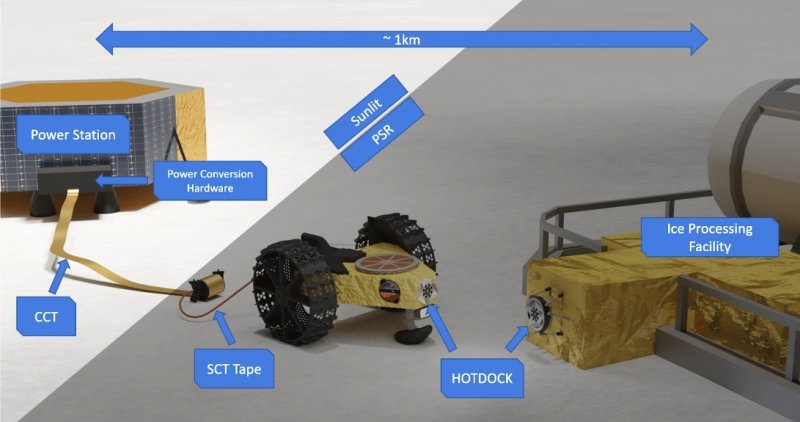
While working on the Watts challenge, the team also submitted a proposal to NASA's inaugural Lunar Surface Technology Research (LuSTR) program, which asked universities to propose advancements in ISRU and sustainable power solutions. In February 2021, the PSTDL was awarded one of six $2 million, two-year grants to develop a heated percussive cone penetrometer—an adaptation of an engineering instrument regularly used on Earth—to characterize the strength of lunar soil. "Understanding a lunar region's soil strength could help us zero in on how to excavate water and build structures using local moon materials," says van Susante.
In August 2021, the team won one of 10 runner-up prizes in NASA's Break the Ice Lunar Challenge, which asked for ideas on digging and hauling icy moon dirt, also known as regolith. Their submission, the Lunar Ice Quest Innovation Design (LIQUID), uses three 200 kilogram–class bucket ladder rovers to dig and two 100 kilogram–class rovers to haul, and could produce 29,000 kilograms of water-ice during a one-year mission. NASA awarded the team $25,000 to further explore the project.
Growing Pains and Field Trips
Building and expanding a lab like this, this quickly, is unusual. van Susante says he had to hire 18 students last summer in one fell swoop. "It's been pretty busy, but it's also been amazing for the students," he says. It's also a team effort, with duties spread from the newest student to, well, himself.
van Susante was the only person on the team who had his own positive pressure air respirator suit when the lab opened. When he realized the lab wouldn't be getting more anytime soon due to COVID-related demand for PPE, he stepped into the regolith sandbox himself. "I was the one in the box shoveling dust for six hours," he says.
But the PSTDL's field trips are worth the chore of dust shoveling. Upper Peninsula winter sites have been perfect for testing the technology of a surface-exploring T-REX. In winter 2022, van Susante and his team brought the rover out to old copper mine sites. Not only do these locations allow the team to run the rover for long distances, but the fields are full of crushed basalt rock from former mining operations.
"There are literally millions if not billions of tons of this crushed rock everywhere," he says. They've been putting ground-penetrating radar on the rover to see how the technologies work together and test the radar's detection capacity. "We've been burying targets like ice blocks and snow mixed with basalt to see how it compares to dry basalt and see if it can tell the difference," he says.
This summer, the team will use their grant funding to create a more controlled, lunar-like trench at the Keweenaw Research Center. The trench, which will require about 100,000 pounds of simulated lunar material, will be a testing ground for the cone penetrometer's effectiveness when combined with radar and the rover. Next winter, the team will take the entire apparatus back outside to re-test with icy lunar regolith simulant.
"To do our final test, we want to create a trench we designed, so we know exactly what the layers are—how much ice and at what depths they exist, where rocks are—and go over it with the system so we make sure we get the profile that we know is there," says van Susante.
The Moon Mentality
van Susante doesn't see going back to the moon as something humans are doing because they can, but because they must. As humans face climate change and energy production challenges, he thinks it's a choice between two mentalities. In the first: "We have to stay in our closed environment and limited in growth and activities, and never leave the Earth, and we just live within what we have," he says. "But since we keep using things, and nothing is 100 percent recyclable, we just keep using things. In a way, that is a 'if you're not growing, you're dying' kind of choice in the long term."
The other mentality—one he holds—is that Earth is just a tiny marble in this giant universe. "Once you're able to leave this place, you have access to unlimited resources and unlimited energy out there, and that includes things we could get and bring back," he says. For example, he points to solar power, which we could generate in space, beam back to Earth using microwave radiation, and then distribute using antennas. This process also wouldn't produce carbon dioxide, which is currently wreaking havoc on Earth's climate.
"We have the technology in principle to do that. There's no magic involved," says van Susante. The biggest challenge is figuring how to explore those possibilities in ways that don't require bringing everything with you via rocket fuel. Work like his facilitates that exploration.
"If you really want to have this future where you have access to unlimited resources and energy, which I think as a species in the long term we really want, we really need to learn how to live locally wherever we go, whether that's the moon or asteroids or Mars or beyond," he says.
Michigan Technological University is an R1 public research university founded in 1885 in Houghton, and is home to nearly 7,500 students from more than 60 countries around the world. Consistently ranked among the best universities in the country for return on investment, Michigan's flagship technological university offers more than 185 undergraduate and graduate degree programs in science and technology, engineering, computing, forestry, business, health professions, humanities, mathematics, social sciences, and the arts. The rural campus is situated just miles from Lake Superior in Michigan's Upper Peninsula, offering year-round opportunities for outdoor adventure.
